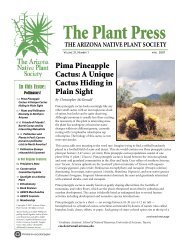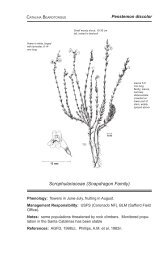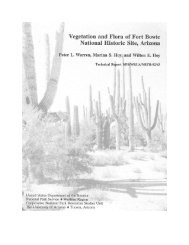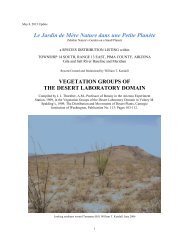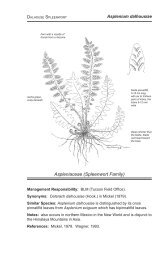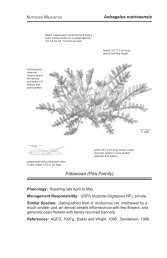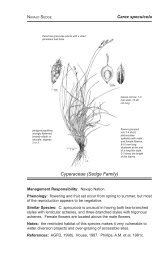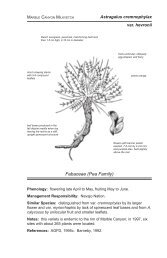- Page 1: May 8, 2013 Updatea SPECIES DISTRIB
- Page 6 and 7: Historic Neighborhoods: Historic Ne
- Page 9 and 10: Sand Dropseed (Poaceae: Sporobolus
- Page 11 and 12: Spreading Fleabane (Asteraceae: Eri
- Page 13: Southwest Rare Plant Task Force to
- Page 17 and 18: sandy-clayey-loamy and clayey slope
- Page 19 and 20: streams, and disturbed areas growin
- Page 21 and 22: Yellow Nutgrass (a name also applie
- Page 23 and 24: also applied to other species, Atha
- Page 25 and 26: ocky-gravelly-clayey-loamy and ston
- Page 27 and 28: Dichelostemma pulchellum), 89 (see
- Page 29 and 30: Aristida hamulosa (see Aristida ter
- Page 31 and 32: along and in creekbeds; riverbeds;
- Page 33 and 34: mountains; rocky mountainsides; roc
- Page 35 and 36: anthers are yellow or yellow & red;
- Page 37 and 38: ecological formations. NOTES: This
- Page 39 and 40: tufted graminoid (erect culms 4 to
- Page 41 and 42: SYNONYMY: Bromus diandrus A.W. Roth
- Page 43 and 44: oadcuts; along rocky, rocky-gravell
- Page 45 and 46: and sandy ground and sandy loam and
- Page 47 and 48: 6, 15 (recorded as Erioneuron pulch
- Page 49 and 50: along (gravelly, sandy and muddy) e
- Page 51 and 52: Long-bristle Wild Rye; Mono’pü (
- Page 53 and 54: SYNONYMY: Pappophorum wrightii S. W
- Page 55 and 56: amongst boulders; dunes; gravelly p
- Page 57 and 58: Eragrostis tephrosanthos (see Eragr
- Page 59: Festuca octoflora (see Vulpia octof
- Page 62 and 63: Hordeum pusillum T. Nuttall: Little
- Page 64 and 65:
as Leptochloa filiformis (Lam.) Bea
- Page 66 and 67:
applied to other species); Beardles
- Page 68 and 69:
Muhlenbergia porteri F.L. Scribner
- Page 70 and 71:
ground; rocky clay, gravelly clay,
- Page 72 and 73:
Panicum saccharatum (see footnote 8
- Page 74 and 75:
ocky-sandy loam and loam ground, an
- Page 76 and 77:
September, three for mid-September,
- Page 78 and 79:
takes place between early March and
- Page 80 and 81:
along rocky, gravelly and clayey-lo
- Page 82 and 83:
gravelly washes; within drainages;
- Page 84 and 85:
exposed to drouth or disease which
- Page 86 and 87:
mountains; gravelly mountaintops; b
- Page 88 and 89:
generally described as taking place
- Page 90 and 91:
from sea level to 4,800 feet in ele
- Page 92 and 93:
dry bouldery, rocky, rocky-gravelly
- Page 94 and 95:
September (additional records: one
- Page 96 and 97:
as Siphonoglossa longiflora (Torr.)
- Page 98 and 99:
gravelly-sandy canyons; rocky and s
- Page 100 and 101:
enzymatic action.”), 77, 80 (This
- Page 102 and 103:
in the woodland, scrub, grassland,
- Page 104 and 105:
drainage ways; along banks of washe
- Page 106 and 107:
to sheep; however, the plants are s
- Page 108 and 109:
from sea level to 6,900 feet in ele
- Page 110 and 111:
Asteraceae (Compositae): The Aster
- Page 112 and 113:
and the genus Ambrosia); Slender Ra
- Page 114 and 115:
have been utilized by native people
- Page 116 and 117:
Aster subulatus var. ligulatus (see
- Page 118 and 119:
streams; streambeds; along gravelly
- Page 120 and 121:
levees; canals; canal banks; rocky
- Page 122 and 123:
Castalis tragus (W. Aiton) N.T. Nor
- Page 124 and 125:
presentation), 86 (color photograph
- Page 126 and 127:
photograph), 43 (111809), 44 (05171
- Page 128 and 129:
Sinaloa) 140 ; Hierba del Caballo (
- Page 130 and 131:
ouldery-stony-gravelly-sandy, rocky
- Page 132 and 133:
sandy clearings in forests and wood
- Page 134 and 135:
Franseria confertiflora (see Ambros
- Page 136 and 137:
orange; there are no ray florets; f
- Page 138 and 139:
Hemizonia pungens (see Centromadia
- Page 140 and 141:
Hierba del Burrow (a name also appl
- Page 142 and 143:
loam ground; silty clay and clay gr
- Page 144 and 145:
Terrestrial annual forb/herb (stems
- Page 146 and 147:
SYNONYMY: Xanthisma spinulosum (F.T
- Page 148 and 149:
(color photograph), 89 (reported as
- Page 150 and 151:
other species, Col. Springs, Califo
- Page 152 and 153:
loam and clayey loam ground; sandy
- Page 154 and 155:
around springs; along streams; stre
- Page 156 and 157:
mid-July). HABITAT: Within the rang
- Page 158 and 159:
SYNONYMY: Sonchus asper (C. Linnaeu
- Page 160 and 161:
(Page 960), 58, 63 (041812 - color
- Page 162 and 163:
and clay ground, and sandy silty an
- Page 164 and 165:
species it has been reported from m
- Page 166 and 167:
orientale); Californian Burr (var.
- Page 168 and 169:
drops rapidly as the first true lea
- Page 170 and 171:
streams; along sandy streambeds; al
- Page 172 and 173:
ocky and gravelly alluvial fans; gr
- Page 174 and 175:
Cryptantha pterocarya (J. Torrey) E
- Page 176 and 177:
Lappula occidentalis (S. Watson) E.
- Page 178 and 179:
sandy-clayey, loamy and clayey flat
- Page 180 and 181:
(Page 712), 58, 63 (051512 - color
- Page 182 and 183:
enchlands; flats; basins; along san
- Page 184 and 185:
disturbed areas growing in muddy gr
- Page 186 and 187:
COMMON NAMES: Desert Whitlow; Draba
- Page 188 and 189:
(062212 - color presentation), 77 (
- Page 190 and 191:
gravelly-sandy and sandy washes; dr
- Page 192 and 193:
purpurea is native to southwest-cen
- Page 194 and 195:
COMMON NAMES: Ban Cenṣañig (“C
- Page 196 and 197:
annual forb/herb (erect stems 4 to
- Page 198 and 199:
washes growing in dry rocky, rocky-
- Page 200 and 201:
Cylindropuntia leptocaulis (A.P. de
- Page 202 and 203:
Cylindropuntia x tetracantha is nat
- Page 204 and 205:
Cactus; Táci (Uto-Aztecan: Souther
- Page 206 and 207:
Opuntia engelmannii J.F. Salm-Reiff
- Page 208 and 209:
discata (Griffiths) L. Benson - “
- Page 210 and 211:
also applied to other species); Spr
- Page 212 and 213:
America and could be investigated t
- Page 214 and 215:
Koeberlinia spinosa J.G. Zuccarini
- Page 216 and 217:
is native to southwest-central and
- Page 218 and 219:
iparian areas, and disturbed areas
- Page 220 and 221:
commercial food, beverage and/or dy
- Page 222 and 223:
gravelly, gravelly-sandy and sandy
- Page 224 and 225:
to livestock where selenium occurs
- Page 226 and 227:
name also applied to the species);
- Page 228 and 229:
mid-March and mid-November (additio
- Page 230 and 231:
from 900 to 11,200 feet in elevatio
- Page 232 and 233:
ecological formations. NOTES: This
- Page 234 and 235:
Suaeda suffrutescens S. Watson (var
- Page 236 and 237:
COMMON NAMES: Red Morning-glory (a
- Page 238 and 239:
formations. NOTE: Crassula connata
- Page 240 and 241:
to 3,000 feet in elevation in the s
- Page 242 and 243:
SYNONYMY: Euphorbia abramsiana L.C.
- Page 244 and 245:
two for late December). HABITAT: Wi
- Page 246 and 247:
appendages; flowering generally tak
- Page 248 and 249:
the woodland, grassland and deserts
- Page 250 and 251:
mid-January and mid-May and again b
- Page 252 and 253:
COMMON NAMES: Limberbush; Matacora;
- Page 254 and 255:
native habitat, the leaves are fern
- Page 256 and 257:
also applied to other species); Dev
- Page 258 and 259:
March and late May (additional reco
- Page 260 and 261:
Astragalus nuttallianus A.P. de Can
- Page 262 and 263:
Cassia bauhinioides (see Senna bauh
- Page 264 and 265:
gravelly-sandy-silty, gravelly-loam
- Page 266 and 267:
and scrub, and disturbed areas grow
- Page 268 and 269:
summer or on the trail), or by graz
- Page 270 and 271:
nothosubsp. varia); Sichelklee (Ger
- Page 272 and 273:
other species, Portuguese: Brazil);
- Page 274 and 275:
located on Tumamoc Hill), 91 (recor
- Page 276 and 277:
desertscrub and wetland ecological
- Page 278 and 279:
Vicia ludoviciana T. Nuttall (subsp
- Page 280 and 281:
genus or species), 127, 140 (record
- Page 282 and 283:
Rosita. DESCRIPTION: Terrestrial an
- Page 284 and 285:
of the Mediterranean region having
- Page 286 and 287:
and clayey washes; sandy-silty play
- Page 288 and 289:
Phacelia coerulea Auct.), 44 (12281
- Page 290 and 291:
Parry Scorpion-weed; Safirfacelia (
- Page 292 and 293:
(010713 - color presentation), 89 (
- Page 294 and 295:
ocky valley floors; along rocky-gra
- Page 296 and 297:
chaparral and coastal sage scrub, a
- Page 298 and 299:
species it has been reported from m
- Page 300 and 301:
Mentzelia jonesii (I. Urban & E.F.
- Page 302 and 303:
height with a crown 40 inches in wi
- Page 304 and 305:
Anoda thurberi (see footnote 89 und
- Page 306 and 307:
ange of this species it has been re
- Page 308 and 309:
gravelly and sandy canyons; along s
- Page 310 and 311:
presentation including habitat; rec
- Page 312 and 313:
Molluginaceae: The Carpetweed Famil
- Page 314 and 315:
sandy, cobbly-pebbly, cobbly-sandy,
- Page 316 and 317:
(reported as being a summer annual
- Page 318 and 319:
also applied to other species and t
- Page 320 and 321:
Fraxinus velutina var. toumeyi (see
- Page 322 and 323:
Munz), 48 (genus, recorded as Oenot
- Page 324 and 325:
presentation), 77, 85 (022013 - col
- Page 326 and 327:
Onagraceae); Hierba Cólica (Hispan
- Page 328 and 329:
lue-green, gray, grayish-green purp
- Page 330 and 331:
strands; along railroad right-of-wa
- Page 332 and 333:
maroon, orange, orange-brown, purpl
- Page 334 and 335:
(powdered roots carried in pocket t
- Page 336 and 337:
(031613), 46 (Page 804), 48 (genus)
- Page 338 and 339:
yellow; the anthers are blue; flowe
- Page 340 and 341:
presentation), 89 (reported as bein
- Page 342 and 343:
mountainsides; mesas; cliffs; bases
- Page 344 and 345:
alluvial fans; gravelly bajadas; ro
- Page 346 and 347:
sandy bottomlands; sandy floodplain
- Page 348 and 349:
generally takes place between mid-A
- Page 350 and 351:
may be green, greenish, greenish-pu
- Page 352 and 353:
Perfoliate Claytonia; Perfoliate Mi
- Page 354 and 355:
ground; gravelly loam, gravelly-sil
- Page 356 and 357:
Potosí) 140 ; Kava Vopar (Uto-Azt
- Page 358 and 359:
the stems may be green or pink-tan;
- Page 360 and 361:
(Athapascan: Western Apache) 140 ;
- Page 362 and 363:
Bouvardia ternifolia (A.J. Cavanill
- Page 364 and 365:
late August, one for early Septembe
- Page 366 and 367:
November 2, 2012, Landmark S. Ariz.
- Page 368 and 369:
(species, color photograph of the s
- Page 370 and 371:
ocky mesas; plateaus; hanging garde
- Page 372 and 373:
58, 63 (041713 - color presentation
- Page 374 and 375:
mountainsides; bouldery and gravell
- Page 376 and 377:
Blue Toad-flax; Large Blue Toadflax
- Page 378 and 379:
(English) 140 ; Quinine-plant; Shee
- Page 380 and 381:
silty swales; (sandy-silty) banks o
- Page 382 and 383:
sandy ground; rocky-sandy loam, san
- Page 384 and 385:
Lycium fremontii A. Gray: Frémont
- Page 386 and 387:
Coyote [Desert] Tobacco (English) 1
- Page 388 and 389:
Physalis acutifolia (J. Miers) N.Y.
- Page 390 and 391:
ocks; bedrock bottoms of caves; cla
- Page 392 and 393:
NOTES: This plant was reported to h
- Page 394 and 395:
Ayenia compacta J.N. Rose: Californ
- Page 396 and 397:
shores of lakes; mudflats; sand bar
- Page 398 and 399:
(Aphelocoma californica) feed on th
- Page 400 and 401:
have been utilized by native people
- Page 402 and 403:
native to southwest-central and sou
- Page 404 and 405:
Viscaceae (Loranthaceae): The Chris
- Page 406 and 407:
Apache) 140 ; U´li (Hispanic); U:d
- Page 408 and 409:
Kallstroemia hirsutissima A.M. Vail
- Page 410 and 411:
for mid-March, two for late March,
- Page 412 and 413:
Heraclides cresphontes (see Papilio
- Page 414 and 415:
it has been reported from freshwate
- Page 416 and 417:
Cathartes aura (Linnaeus, 1758): Tu
- Page 418 and 419:
Chondestes grammacus (Say, 1823): L
- Page 420 and 421:
and wetland ecological formations.
- Page 422 and 423:
formations. *14 (042212 - subsp. lo
- Page 424 and 425:
Icteria virens (Linnaeus, 1758): Ye
- Page 426 and 427:
species it has been reported from w
- Page 428 and 429:
Selasphorus rufus (Gmelin, 1788): R
- Page 430 and 431:
Vireonidae: The Vireo FamilyVireo b
- Page 432 and 433:
Ovis canadensis Shaw. Bighorn. Prob
- Page 434 and 435:
COMMON NAMES: Kit Fox; Desert Kit F
- Page 436 and 437:
White-tailed Deer (O.v. leucurus (D
- Page 438 and 439:
Felis yaguarondi (see Puma yagouaro
- Page 440 and 441:
cottontail rabbits, coyotes, deer (
- Page 442 and 443:
(Distribution: mapping and records
- Page 444 and 445:
Chaetodipus penicillatus subsp. pri
- Page 446 and 447:
118 (recorded as Perognathus flavus
- Page 448 and 449:
Mephitidae: The Skunk FamilyConepat
- Page 450 and 451:
desertscrub and wetland ecological
- Page 452 and 453:
(species), 100 (species, color phot
- Page 454 and 455:
present known only from a few scatt
- Page 456 and 457:
located in dens dug in banks or wit
- Page 458 and 459:
118 (recorded as Bassariscus astutu
- Page 460 and 461:
Citellus harrisii (see Ammospermoph
- Page 462 and 463:
Tayassu tajacu subsp. sonoriensis (
- Page 464 and 465:
Ursus horribilis subsp. texensis (s
- Page 466 and 467:
species), 100 (species, color photo
- Page 468 and 469:
townsendii, includes a listing of s
- Page 470 and 471:
Callisaurus draconoides Blainville,
- Page 472 and 473:
Plan website. Extensive revisions m
- Page 474 and 475:
(8) Arizona Game and Fish Departmen
- Page 476 and 477:
(17) Breitung, August J., The Agave
- Page 478 and 479:
(59) Medina, Alvin L. 2003. Histori
- Page 480 and 481:
(93) Udvardy, Miklos D.F. 1977. The
- Page 482 and 483:
(127) Native American Ethnobotany,
- Page 484:
(ANPS) Arizona Native Plant Society



